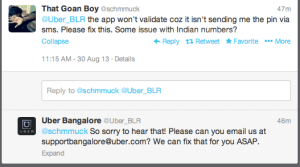Transportation tech startup Uber is continuing its aggressive expansion across Asia. As of this week, it is now live in India, starting first with a luxury car service in its tech capital, Bangalore. The subcontinent may boast a potential market of over a billion, a rising middle class and 164,000 millionaires, but these are silver linings to some possibly darker storm clouds: low credit card and smartphone penetration, inadequate infrastructure, and low levels of disposable income. Uber will try to impose its premium and efficient model on the market, but entrenched indigenous operators, whose lo-fi solutions have thrived, won’t give up their turf without a fight.
So far this year, the private transportation startup has been on a tear in Asia and it last night discreetly announced that Bangalore would be the latest cab off the rank. The strategy is being fuelled in part by a $258 million investment led by Google Ventures, which values the company at $3.5 billion. In India, the initial strategy appears to be an extension of what occurred in Singapore, Seoul and Taipei, where the service was positioned as a luxury option better than the status quo. The Bangalore launch comes amid a trio of debuts in three consecutive days, with Dubai and Cape Town preceding the India debut.
Uber hasn’t spelled out what its bigger plans are for India — whether it will be about trying to replicate the same roll-out in this emerging market as it has done in places like the U.S. by starting with luxury car services and then expanding from there. Luxury car services could be Uber’s canary in the mine in India, laying the groundwork before sending in subsequent waves of logistics services as well as targeting the mid-level segment via its Uber X brand. What seems more apparent as that, after proving the model at home and enjoying the proceeds of its long-tail revenue model, the firm is now looking to emerging markets for the next wave of growth.
In India, companies have generally failed, or only enjoyed modest success, when they try the model of making consumers pay for the privilege of excellent customer service. However, some believe that bucking the trend might work in its favor.
“In the US. they started with the black limo, the premium service, and people raved about Uber’s fabulous experience. It wasn’t just another taxi experience. From booking to ride to wait-time to payment, it was seamless and I think that over time they have broadened their offering in the U.S. Here, it’s interesting they’re not selling out and saying ‘let’s go into mass part of market’,” said Somaia.
“What I see more often in India is just get a focus on getting big, whether that’s scaling through inefficient marketing spend, coupons or discounts. Here cars arrive late, they’re not clean, drivers aren’t particularly knowledgable: it’s fairly poor, broken customer experience,” said Lightspeed Ventures partner Bejul Somaia. “Even if they are saying ‘fine, we’re going to have slightly more premium offering, and the trade-off is scale,’ the point is they’re focused on superior consumer experience.”
In India’s taxi service today, it’s fair to say that you get what you pay for. Taxis are often smelly, dirty and uncomfortable but they get you from a to b.
Bhavish Aggarwal, co-founder and CEO of one of the country’s biggest taxi booking platforms Ola Cabs, estimates that in Bangalore there are only around 100 drivers licensed to drive luxury cars, compared with about 50,000 drivers authorised to carry passengers in medium to low-end vehicles.
The huge differential highlights the low interest in luxury services, he said. He believes that Uber has about eight luxury cars on its books and will find it difficult to sustain its cheap introductory prices and establish a solid foothold.
We reached out to Uber India’s spokesperson, who declined to comment for this article.
Even if Uber can grab some market share in the small luxury segment, it will need to navigate its way around some pretty big cultural hurdles before it can reach the untransported masses. Here, the majority of Indian consumers don’t have a credit card or smartphone, nor the financial incentive to catch a taxi (autorickshaws are still the cheapest, quickest way to move around the city, more below). A few major players have started tackling the e-payments problem but a mass market solution is still a few years off.
For now, locals prefer to book over the phone and pay via cash.
Unlike Uber’s build-it-and-they-will-come strategy, local players have typically used available, accepted methods to gain the trust of consumers and later introduced innovative technologies to improve the experience. India’s most successful startups, such as Flipkart, JustDial, and RedBus, are the ones that bent to the will of the people, and not the other way around.
Almost 95% of Ola Cabs’ passengers pay cash. And 80% of their bookings are taken via the call centre — over 10,000 customer calls a day. India’s largest radio taxi network Meru Cabs said that 60% of its 20,000 daily bookings are done over the phone, with the rest coming from mobile internet and the web.
Aggarwal’s three-year old firm has signed up about 6,000 drivers servicing customers in four cities, and expects to hit $100 million by the end of the current financial year, ending in April 2014. He believes that you need to customise solutions for the local market. “My feeling is that launching a luxury brand is good for the luxury people that can afford it but for India you need to build an Indian solution,” he said. “You can’t just copy a Western solution for India. You need to solve the local problems.”
Yet Indians appear to be itching for a change.
Ola has offered a slick smartphone app for about a year, which shows the distance from the nearest taxi on the launch screen. Meru recently launched its own mobile apps , which feature an emergency distress button, in order to boost the number of bookings made from the smartphone app.
The number of bookings Ola has processed through its mobile app has increased by 100% quarter-on-quarter since it was launched in August 2012. And over two million people have visited the Android and iOS apps, while five million visited the website in the last year.
Cash Cab
 In Bangalore Uber is charging a base fare of 150 rupees ($2.50), and a minimum of 250 rupees (~$4). It has secured an undisclosed number of Mercedes, Toyota Corolla Altis and Honda Civics for the task, but being conveyed in the lap of luxury will cost Indians 20 rupees per kilometre, and a waiting time of two rupees per minute — this usually ends up being quite lucrative considering the lengthy waiting times on Bangalore’s heavily congested, poorly constructed roads. There’s also a 100 rupee cancellation fee if you give the Uber driver a bum steer.
In Bangalore Uber is charging a base fare of 150 rupees ($2.50), and a minimum of 250 rupees (~$4). It has secured an undisclosed number of Mercedes, Toyota Corolla Altis and Honda Civics for the task, but being conveyed in the lap of luxury will cost Indians 20 rupees per kilometre, and a waiting time of two rupees per minute — this usually ends up being quite lucrative considering the lengthy waiting times on Bangalore’s heavily congested, poorly constructed roads. There’s also a 100 rupee cancellation fee if you give the Uber driver a bum steer.
It might sound cheap by western standards but it doesn’t compare with the competition.
The country’s biggest radio taxi service, Meru Cabs, with a fleet of 5,500 air-conditioned small sedans, doesn’t charge a call out fee. It charges 80 rupees for the first four kilometres and 19.50 rupees for every additional kilometre. Waiting time is 10 rupees for 15 minutes. Meru recently launched mobile apps to boost its bookings.
So that means that a Uber cab will cost twice as much as the competition, who also don’t charge you a cancellation fee. A fare of 150 rupees in other taxis would get you from the centre of Bangalore “CBD” to the city’s outskirts, which are around 15 kilometres to 20 kilometres away. Uber’s flat rate of 2000 rupees to travel to the airport from the main city area, is nearly double what you would pay the other operators.
If you are comfortable venturing in an open, small-moving, lawnmower-engine powered three wheeler, known as ‘autorickshaws’, you can travel for about half or two-thirds of the expense of a regular taxi — or about the quarter of the price of an Uber cab.
All other operators accept cash, while Uber requires a valid credit card to sign up which is a huge barrier to entry in a country where most of the population still transact using paper money.
 Already there have been a few teething problems with first customers hoping to participate in the pilot, but the firm has been very responsive on Twitter and appears to have waived the mobile verification process. Customer can also book via the website.
Already there have been a few teething problems with first customers hoping to participate in the pilot, but the firm has been very responsive on Twitter and appears to have waived the mobile verification process. Customer can also book via the website.
Uber’s Indian soft-launch involved ferrying two of Bangalore’s rich celebrities, but that leaves question marks over a strategy to target the city’s minority elite. Here, most of the wealthy locals and well-resourced foreigners have access to a car, either their own or via their employer, which comes with a full-time driver — who cost about 10,000 rupees per month ($160) or just over 300 rupees a day — to chauffeur them at a moment’s notice.































Comment